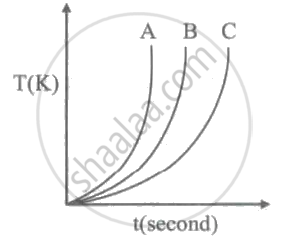Advertisements
Advertisements
प्रश्न
What amount of heat must be supplied to 2.0 x 10-2 kg of nitrogen (at room temperature) to raise its temperature by 45 °C at constant pressure? (Molecular mass of N2 = 28; R = 8.3 J mol-1 K-1.)
उत्तर १
Mass of nitrogen, m = 2.0 × 10–2 kg = 20 g
Rise in temperature, ΔT = 45°C
Molecular mass of N2, M = 28
Universal gas constant, R = 8.3 J mol–1 K–1
Number of moles, `n = m/M`
`= (2.0xx10^(-2)xx10^3)/28 = 0.714`
Molar specific heat at constant pressure for nitrogen, `C_P = 7/2 R`
`= 7/2 xx 8.3`
`= 29.05 J mol^(-1) K^(-1)`
The total amount of heat to be supplied is given by the relation:
ΔQ = nCP ΔT
= 0.714 × 29.05 × 45
= 933.38 J
Therefore, the amount of heat to be supplied is 933.38 J.
उत्तर २
Here, mass of gas,` m= 2xx 10^-2 kg` = 20 g
rise in temperature, `triangleT = 45 ^@C`
Heat required, triangleQ = ?, Molecular mass, M = 28
Number of moles , `n = m/M = 20/28 = 0.714`
As nitrogen is a diatomatic gas,molar specific heat at constant pressure is
`C_p = 7/2R = 7/2 xx 8.3 J mol^(-1) K^(-1)`
As `triangleQ = nC_p triangleT`
`:. triangleQ = 0.714 xx 7/2 xx 8.3 xx 45 J = 933.4 J`
APPEARS IN
संबंधित प्रश्न
50 g of metal piece at 27°C requires 2400 J of heat energy so as to attain a temperature of 327°C . Calculate the specific heat capacity of the metal.
Heat supplied to a solid change it into liquid. What is this change in the phase called?
Why do the farmers fill their fields with water on a cold winter night?
The specific heat capacity of water is :
The specific heat capacity of a body depends on _____________ .
The product of mass and specific heat is known as ..........
Define heat capacity and state its units.
What are other units of heat? Name and define them.
Is it possible to condense the water formed, back to ice by adding ice at 0°C. Explain with reason.
The temperature of a lead piece of mass 400 g rises from 20°C to 50°C when 1560 J of heat is supplied to it. Calculate: Heat capacity of lead piece.
State factors on which the amount of heat radiated by a body depends.
Derive Meyer’s relation for an ideal gas.
A diatomic gas undergoes adiabatic change. Its pressure 'P' and temperature 'T' are related as p ∝ Tx, where x is ______.
Which of the following substances (A, B and C) has the highest specific beat?

Two metals A and B have specific heat capacities in the ratio 2 : 3. If they are supplied the same amount of heat then
Which metal piece will show a greater rise in temperature given their masses is the same?
Specific heat capacity C = ______.
We would like to make a vessel whose volume does not change with temperature (take a hint from the problem above). We can use brass and iron `(β_(vbrass) = (6 xx 10^(–5))/K and β_(viron) = (3.55 xx 10^(–5))/K)` to create a volume of 100 cc. How do you think you can achieve this.
Specific heat capacity of a substance X is 1900 Jkg-1°C-1 means ______.
Thermal capacities of substances A and B are same. If mass of A is more than mass of B then:
Which substance will have more specific heat capacity?
